1. Features, specifications
We have in our labs Kingston's latest solid-state drives (SSDs) for PCs and laptops, the SSDNow V300 Series. Designed to replace the existing SSDNow V200 models, the V300 should offer sequential read and write speeds of around 450MB/s - somewhere between five and 10 times faster than a traditional mechanical hard drive.
The V300 SSDs use a customized LSI SandForce SF-2281 controller, along with 19nm NAND flash memory components for storing the data.
Based on a 2.5-in form factor, the V300 Series is available in 60GB, 120GB and 250GB capacities as either a bare drive or as an upgrade kit which includes a caddy, mounting bracket and software for transferring data from an existing hard drive or SSD.

Specifications |
|
|
|
| Performance |
60 GB |
120 GB |
240 GB |
| Sequential Reads |
450 MB/s |
450 MB/s |
450 MB/s |
| Sequential Writes |
450 MB/s |
450 MB/s |
450 MB/s |
| Random 4k Read IOPS |
85,000 IOPS |
85,000 IOPS |
85,000 IOPS |
| Random 4k Write IOPS |
60,000 IOPS |
55,000 IOPS |
43,000 IOPS |
| PCMARK Vantage HDD Suite score |
39,000 |
49,000 |
57,000 |
| Physical |
| Usable Capacities (IDEMA) |
60GB, 120GB, 240GB |
| NAND Components |
|
| Interface |
SATA Rev. 3.0 (6Gb/s) – with backwards compatibility to SATA Rev. 2.0 |
| Form Factor |
2.5 Inch |
| NAND Controller |
LSI SandForce |
| Weight |
86g |
| Dimensions (L x W x H) |
69.8mm x 100.1mm x 7mm |
| Reliability/Protection |
|
Total Bytes Written (TBW)*
*How much total data can be written to an SSD for a given workload before the
drive reaches its endurance limits. |
60GB: 32TB
120GB: 64TB
240GB: 128TB |
| MTBF |
1 million hours MTBF |
| Environmental |
|
| Power Consumption |
0.640W Idle / 1.423 W Read / 2.052 W Write |
| Operating Temperature |
0°C ~ 70°C |
| Storage Temperature |
-40°C ~ 85°C |
| Shock Resistance |
Vibration operating: 2.17G peak (7–800Hz)
Vibration non-operating: 20G peak (10–2000Hz) |
| Service & Support |
Three-year warranty with free technical support |
| |
60 GB |
120 GB |
240 GB |
| Part Numbers |
SV300S37A/60G (stand-alone drive) |
SV300S37A/120G (stand-alone drive) |
SV300S37A/240G (stand-alone drive) |
| SV300S3D7/60G (Desktop upgrade kit) |
SV300S3D7/120G (Desktop upgrade kit) |
SV300S3D7/240G (Desktop upgrade kit) |
| SV300S3N7A/60G (Notebook upgrade kit) |
SV300S3N7A/120G (Notebook upgrade kit) |
SV300S3N7A/240G (Notebook upgrade kit) |
| SV300S3B7A/60G (Desktop/Notebook upgrade kit) |
SV300S3B7A/120G (Desktop/Notebook upgrade kit) |
SV300S3B7A/240G (Desktop/Notebook upgrade kit) |
2. The package
The SSDNow V300 retail package is shown below:

The package of the stand-alone version of the drive includes a 3.5" bracket & mounting screws, SATA data & power cables, a hard drive cloning software (CD) and an installation video (DVD)


Externally, the SSDNow V300 looks just like all the "V" series SSDs available by Kingston with a gray aluminum shell and the familiar black and red Kingston branded sticker on the front with the drive model and capacity displayed.
Inside the exterior casing there is the drive's PCB with the SandForce SF-2281 flash storage processor and 16 modules of Toshiba’s brand new 19nm 8GB MLC Toggle Mode NAND flash memory.
There is actually 128GB of total NAND flash memory although 8GB are reserved for SandForce over provisioning needs, so once formatted, 112GB of available capacity is available to the user.


This drive has a SATA connection, and although it is backward-compatible with SATA 3Gb/s, a native 6Gb/s motherboard is required for maximum performance.
The drive came with firmware Ver. 505ABBF0 installed and as you see below, the available capacity for the end-user is 114.473MB. The difference is mostly the conversion of GB to GiB plus a bit of space set aside for over provisioning that the controller uses to maintain the drive over time in an effort to mitigate performance degradation.
The readout on CrystalDiskInfo shows that both NCQ and S.M.A.R.T. are enabled, as well as TRIM and the interface is confirmed at SATA 6Gbps:


3. HDTune benchmark
Here is our testbed:
- Motherboard: Foxconn Quantum Force Rattler P67 vP04 BIOS
- Processor: Intel Core i5-2500K
- Case: Open Air testbed
- Power Supply Unit: Club 3D CSP-X1000CB 1000 Watt
- Graphics card: Club3D Radeon HD 6790 CoolStream Edition
- Memory: OCZ Gold PC3-10600 4x2GB 1333@CL9
- HDD: WD 500GB 7200RPM
- Monitor: LG L246WH-BH 24"
- Windows 7 x64 SP1 with latest updates installed
For the tests, we used the following software:
- HDTachRW v3.0.1.0
- HD Tune v4.50 Pro
- Crystal DiskMark v3
- ATTO Disk Benchmark v2.46
- ASS SSD Benchmark 1.5xxx
- IOMeter v2006.07.27 with Xtreme Benchmark template
- PCMark Professional edition v1.04
- Anvil Storage Utilities 1.0.34. Beta 11
We start the tests with the HDTachRW software. It shows the potential read speed which you are likely to experience with the SSD.
The software measures the sequential read speed, the random access speed and sequential write speed.
The reported average sequential writing speed was 432.6 MB/s and the average sequential reading of 411.4 MB/s are close to the typical figures quoted by Kingston (450 MB/s.)

We move on to the HD Tune Pro software, another utility we used to measure the drive's reading and writing performances. Although not necessarily representative of real-world workloads, HD Tune's targeted tests give us a glimpse of each drive's raw capabilities.
This time the sequential reading test showed a 294.4 MB/s average speed and the corresponding sequential writing test a 210.6 MB/s average, which are both lower than we expected:
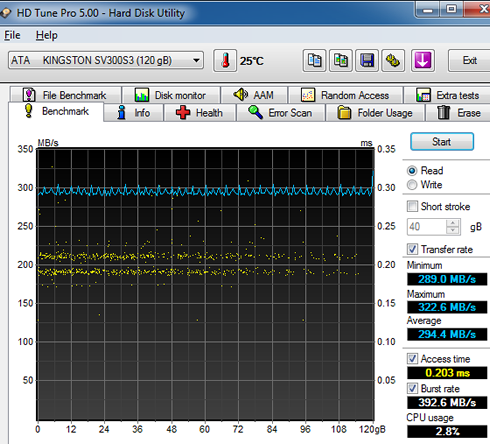
As you see in the screenshot below, writing was not stable across the data sequence and the reading speed was peaking at around 401.1 MB's. This behavior is attributed to the was the specific benchmark operates.

HD Tune's file benchmark consists of two parts: the transfer speed test and block size test.
The transfer rate test measures three different parameters for both reading and writing:
- Sequential: the sequential speed is measured and shown on the graph. Ideally the transfer
speed line should be straight and smooth.
- 4 KB random single: this test measures the performance of I/O operations of 4096 byte blocks - the most common I/O operation on a typical system. Especially the 4 KB write speed is
an important indication of general system performance.
- 4 KB random multi: this test is similar to the 4 KB random single test except that multiple
requests are sent simultaneously to the device. We set the number of operations to 32.
There are also three data patterns available that can be used during the write process: zero, random and mixed, which is a combination of zeroes and random data.
Certain
SSDs use a compression technique which improves performance when compressible data is
used.
For these devices the results will be highest when writing zeroes and lowest when writing
random data.
Let's start with a sequential transfer speed of a 500MB file using zeros in the writing part:

The Kingston drive read the 500MB file at an average speed of 459.9 MB/s and wrote the file at 490.7 MB/s - pretty fast in both cases. The 4K random single performance with 4096 byte blocks was 7436 IOPS for reading and 22373 IOPS for writing. When we enabled the 32 requests option, both figures were boosted at 34945 IOPS and 87771 IOPS, respectively.
Selecting the "Random" data pattern (zeroes and data) had no serious impact to drive's sequential read performance but influenced the drive's write performance, which was decreased at 166.543 MB/s

The reading result with a "mixed" data pattern was very high. In the writing part, the drive was again slower than at the "zero" pattern test, due to its compression algorithm:

4. ATTO Disk Benchmark
The next software we used was the ATTO Disk Benchmark. The tool measures storage systems performance with various transfer sizes and test lengths for reads and writes. The benchmark performs file transfers ranging from 0.5 KB to 8192 KB. ATTO can be adjusted to do overlapped I/O, in a variety of queue depths. We tested the SSD using the benchmark's default settings, using 256KB file length performance and QD4. ATTO probably gives the most accurate results for compressible read and write data.

In the write test the Kingston drive reached over 530MB/s in the block sizes larger than 1MB. The read test was more than 500MB/s - our max was 513MB/s with 2MB files.
The drive's sequential read speed is higher with larger transfer sizes. Reading of small files (4KB) was average and the drive performed as fast as the the Hyper X 120GB SSD and the larger OCZ Vertex 3 MAX IOPS 240GB:

On the other hand, the SSDNow300V was very fast when it was writing such small files (compressible):
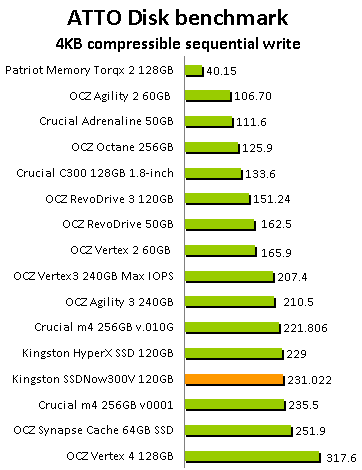
Going further to larger file transfers, the SSDNow300V drive is not the fastest you can find during reading but delivers a great performance in the writing tasks:
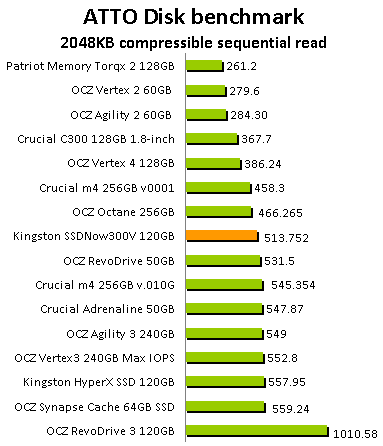
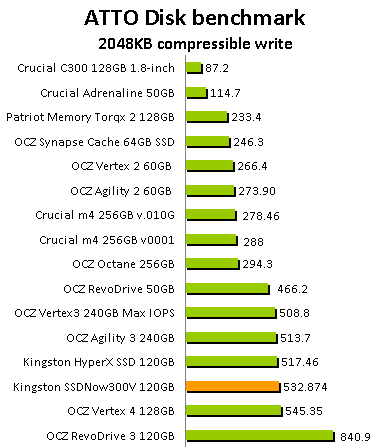
5. CrystalDiskMark
The next benchmark is the CrystalDiskMark. The software provides throughput data based on sequential reads and writes, and random (512K/4K/4KQD32) reads and writes of various sizes.
Below you see the drive;s performance with compressible data:

As we previously saw, the SSDNow V300 120GB SSD will perform according to its official specs in the sequential reading and writing tasks. The drive reads smaller random files a little bit slower than the competition, especially as queue depths increases:
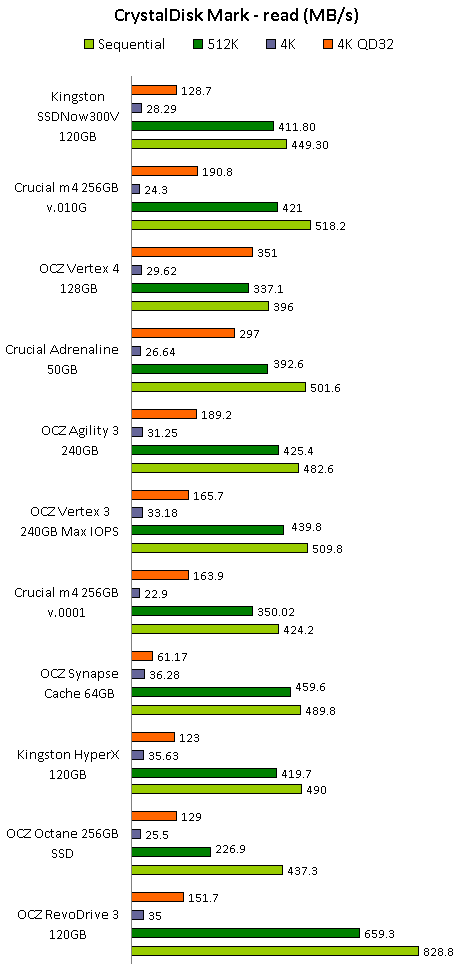
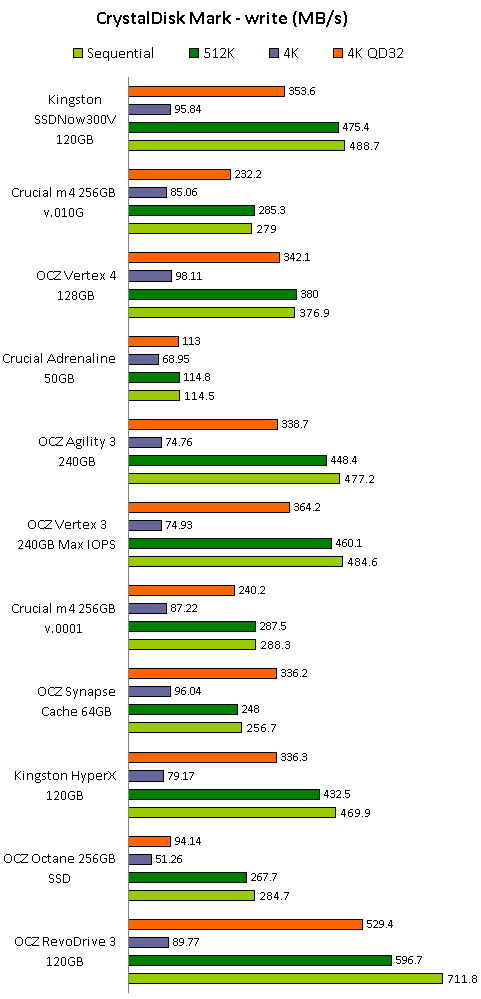
6. AS SSD benchmark
We proceed with the AS SSD benchmark, which contains five synthetic as well as three practical tests. The synthetic tests determine the sequential and the random read / write performance of an SSD. These tests are carried out without using the operating system's cache. The Seq-test measures how long it takes to read and write an 1GB file. Most importantly, this sequential benchmark uses incompressible data for all of its transfers.
The 4K benchmark tests the read and write performance for random 4K blocks. The 4K-64-THRD-test corresponds to the 4K procedure except that here the read and write operations are distributed on 64 threads:

The SSDNow V300's performance in sequential reading with incompressible test was adequate (479 MB/S), matching the performance quoted by Kingston. That was not the exactly case with sequential writing, where the drive was slower and wrote the incompressible files at just 162.96MB/s (average). That's a typical behavior of Sandforce controllers:
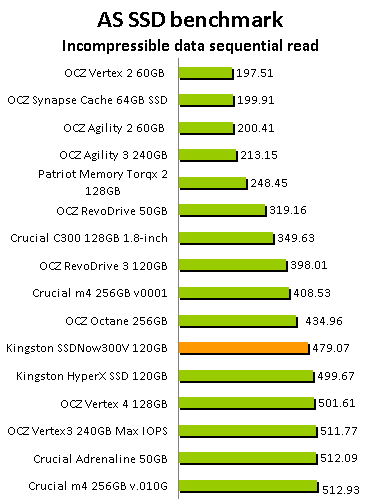

At the 4K random reading tests, the SSDNow V300 120GB ranks somewhere in the middle of the chart below, with an average reading speed of 21.36MB/s.
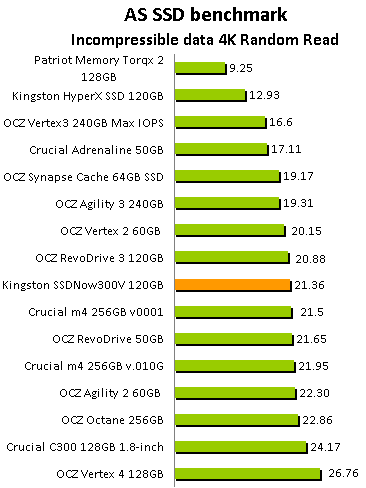
The drive was fast in 4K random reading tests with 72.6 MB/s:

Multi-theraded requests for random reading of 4K incompressible files was more demanding for the drive. It read the files at 119.52 MB/s, but it was faster at the corresponding writing benchmark with 156 MB/s:

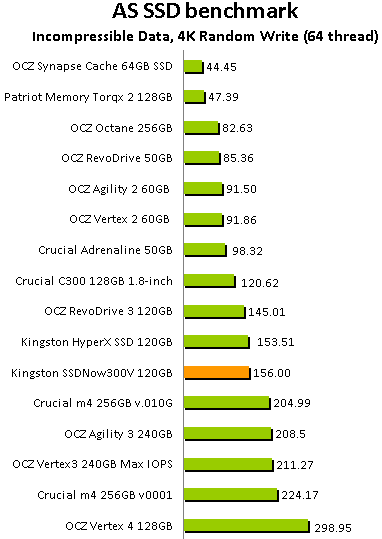
In the following graph you see how the SSDNow V300 120GB drive reads and writes files, which have been partially of fully compressed. It is obvious that the drive's reading performance is steady with all kind of data and the writing speed heavily depends on compression level of the files:

7. IOMeter benchmark
We proceed to IOMeter benchmark. Iometer is run by using workstation and database patterns for queue depths (outstanding I/Os) representing very light and moderate loads. Iometer is both a workload generator (that is, it performs I/O operations in order to stress the system) and a measurement tool (that is, it examines and records the performance of its I/O operations and their impact on the system). The app's ability to bombard drives with an escalating number of concurrent IO requests also does a nice job of simulating the sort of demanding multi-user environments that are common in enterprise applications. The software can be used for measurement of the performance of an SSD. We started using the IOMeter tests using the Xtreme Benchmark template .

For the specific test, we used 100% random, 67%-33% Read/write distribution, aligned with the benchmarks we had already done in the past with other SSDs.
The SSDNow V300 120GB followed closely the HyperX 120GB SSD in terms of IOPs, but it remains slower than other SSDs such as the OCZ Vertex 4 120GB:



8. Anvil Pro SSD Benchmark
The next benchmark is the Anvil Pro, an ‘all inclusive’ storage utility. The software is tests transfer speeds as well as IOPS The IOPS tests can be configurable with preset testing scenarios for read (Seq 4MB, 4K, 4K QD4, 4K QD16, 32K and 128K), write (Seq 4MB, 4K, 4K QD4, 4K QD16) and mixed IO.
We used the software with the Vertex 4 128GB SSD and tested the drive with 0-fill compression (RAW), 8% compression, 25% compression, 45% compression, 67% compression and finally 100 % (incompressible data). Below are the results:






In the following charts we illustrate the results we got from four different drives with 0-fill compression as well as with incompressible files.


9. PCMark 7 benchmark
Below you see the results of Futuremark's PCMark 7 Professional edition. The software includes 7 PC tests for Windows 7, combining more than 25 individual workloads.
The SSDNow V300 120GB drive scored 5298 points.

Below you can see the breakdown of individual benchmarks with the testing methodology. The SSDNow V300 120GB scored a high 5298 score at the storage benchmark, while it also maintained high performances in the corresponding sub-tests:


10. Summary
The Kingston SSDVNow SSD is the first SSD to use new Toshiba 19nm Toggle mode DDR memory paired with the SandForce SF-2281 controller.
As a Sandforce-based drive, the Kingston SSDNow V300 120GB performed better with compressible rather than with incompressible files, at least in writing tests. Specifically, with small 4K compressible files the drive performed almost as fast as its enthusiast-grade brother, the Kingston HyperX 120GB SSD, as well as another competitor, the Crucial m4 SSD. However, the SSDNow V300 showed its weakness at higher queue depths (QD) when reading 4K compressible files.
In the writing part with compressible 4K files, the drive was fast and again kept going head-to- head with the HyperX, although it lagged behind its main competitor in the category, the OCZ Vertex 4 120GB. Surprisingly, the SSDNow V300 120GB did it very well with writing 4K compressible files in higher QD32.
The Kingston SSDNow V300 drive is fast with larger ( 2MB-4MB) compressible files in both reading and writing tasks, closing the gap with the Vertex 4 SSD.
The drive had also a very good sequential read and write performance with compressible files, both rated at around 450MB/s or even higher, confirming its official specifications quoted by Kingston. Sequential writing with incompressible files was very slow, as it typically happens with Sandforce-based drives. Here both the Crucial m4 and the OCZ Vertex 4 SSDs excel.
Speaking of incompressible files, the Kingston SSDNow V300 120GB SSD had an average random read performance with small files, which generally decreased at higher QD and when multiple
requests were sent simultaneously to the SSD. On the other hand, the drive's speed when writing of 4K incompressible files was adequate matching the performance of the Vertex 4 SSD, at least in low queue depths.
With all that in mind and the very high competition at the SSD market, it's always hard to come up with a recommendation. While the drive's performance is not what we would call top notch, it's certainly decent. Price-wise, the Kingston SSDNow V300 120GB is a good deal, provided that priced at $109.99, it would cost you $1.04/GB. At the same price-range, you will find the Kingston HyperX 120GB, the Crucial M4 SSD and the OCZ Vertex 3 MAX IOPS priced at $115. The faster Vertex 4 would cost you $30 more.